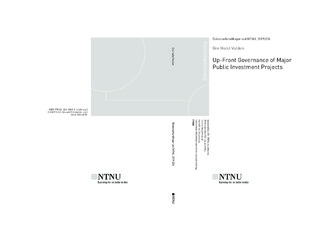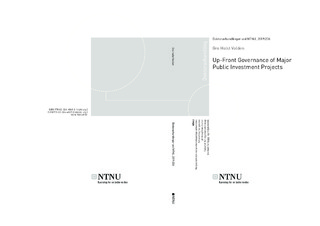| dc.contributor.advisor | Lædre, Ola | |
| dc.contributor.advisor | Odeck, James | |
| dc.contributor.advisor | Haavaldsen, Tore | |
| dc.contributor.author | Volden, Gro Holst | |
| dc.date.accessioned | 2020-01-10T10:02:26Z | |
| dc.date.available | 2020-01-10T10:02:26Z | |
| dc.date.issued | 2019 | |
| dc.identifier.isbn | 978-82-326-4069-0 | |
| dc.identifier.issn | 1503-8181 | |
| dc.identifier.uri | http://hdl.handle.net/11250/2635643 | |
| dc.description.abstract | Traditionally, project success has been interpreted in a narrow, operational sense, concerning the question of How to implement the project. More recently, the need to take a wider tactical and strategic view has been increasingly recognized, and includes the questions of Why and What, both of which concern the choice of concept. A project concept is a construct of thought that is meant to solve a problem or satisfy specific needs, and thus includes the entire business case.
In line with the broader interpretation of project success, the crucial role of the front-end phase of projects has been highlighted in literature. This is the stage from when the idea is conceived until a final implementation decision is made, during which it is still possible to make changes or to terminate the project, at an affordable cost. The key actor in this phase should be the project owner (the financing party), not the project manager. In major statefunded projects the Government is the true project owner on behalf of all taxpayers.
The starting point of this thesis was the need for a better understanding of success in public projects, how to govern them and how to evaluate them, with particular focus on the frontend phase and the choice of conceptual solution. Front-end management and project governance are still under-researched in the literature, and few empirical studies demonstrate experiences relating to governance frameworks.
In the year 2000, the Norwegian Ministry of Finance introduced an overall project governance framework applying to its largest projects, and the scheme was expanded in 2005 to include the choice of concept. The framework is often referred to as the Quality Assurance Scheme (the QA scheme), as it includes two external reviews during the front-end:
1. Quality assurance of the conceptual solution (QA1), performed at the end of the prestudy phase, before a Cabinet decision on whether to start a pre-project.
2. Quality assurance of the cost and management base (QA2), performed at the end of the pre-project phase, before the project is submitted to Parliament for approval and funding.
Together, the two intervention points are intended to cover all the three questions of Why, What and How. The intention is to ensure quality-at-entry before the final decision to fund a project is made.
The QA scheme has provided researchers with an exceptional opportunity to follow and learn from experiences as regards this specific initiative, taken by a government with the aim to improve the success of public projects. Reference to the scheme is therefore used extensively throughout the thesis, and strengths and weaknesses of the scheme are discussed as part of the research.
Three research questions have guided this PhD process. Although the scope of the research is major public projects in Norway and the Norwegian QA scheme, the research questions are broad and open, as I wanted to develop deeper learning, rather than to test a set of hypotheses:
RQ1. What are the main challenges in front-end management of projects?
RQ2. How can project success be achieved through project governance frameworks?
RQ3. How can project success be achieved through improved appraisal and evaluation methods?
The thesis consists of nine papers, each of which addresses a different issue and takes a different perspective. Together, they offer an overall picture of the potential for improving project performance through the use of project governance frameworks and better appraisal and evaluation models. Most of the studies reported in the papers were designed as multiple case studies, based on data gathered through document reviews, interviews and observations. Data analysis consisted of rather simple qualitative coding, categorization and summarizing of findings.
The first research question—RQ1 What are the main challenges in front-end management of projects?—is addressed in Papers 1–3. These papers are based on literature reviews and a number of Norwegian cross-case analyses of pre-QA1 projects. Weaknesses and challenges in the front-end of public projects are framed as ten paradoxes in Paper 1. A key message is that strategic project success and front-end management ought to be given more attention. Despite the now well-known recommendations for exploring problems, needs, and alternative solutions (the Why and What questions), there is still a tendency to jump rapidly to the more narrow and short-term project management issues (the How question). Consequently, the financing party ought to make sure that all the three questions are properly addressed. Funding should be considered part of the conceptual solution, and perverse incentives during project initiation should be avoided.
The second research question—RQ2 How can project success be achieved through project governance frameworks?—is addressed in Papers 4–6, all of which are based on empirical studies. They discuss preliminary experiences relating to the Norwegian QA scheme compared with similar schemes in other countries. The Norwegian scheme is largely in line with key recommendations from the literature, and results are promising thus far. The use of external QA reviews has been essential. Interestingly, such a simple scheme established at the topmost level has triggered improved practices in ministries and agencies. However, some of the paradoxes in Paper 1 seem more difficult to overcome, and the findings in Papers 4-6 indicate that central government should continue to emphasize the importance of the tactical and strategic aspects. There is an opportunity for countries with similar schemes to learn from each other in order to develop and improve their own schemes. For example, the Norwegian Government may benefit from the experiences of countries that have introduced intervention points at an earlier stage.
A somewhat worrying finding is the large number of projects in which the government did not adhere to QA1 recommendations based on value for money as the overall success criterion. This gave rise to the third research question—RQ3 How can project success be achieved through improved appraisal and evaluation methods?—which is addressed in Papers 7–9. A recurrent theme is that strategic project success is a multifaceted term, and that this ought to be reflected in the appraisal and evaluation models. In particular, “value for money” as measured by the cost-benefit analysis is not accepted by decision-makers as the only success criterion. If the cost-benefit analysis is overemphasized by quality assurers, there will be a risk that decision-makers will ignore their advice altogether. Instead, I recommend a framework based on the OECD DAC criteria, and present experiences of its application to 20 completed projects.
The contribution of this thesis is its exploration and synthesis of various challenges and weaknesses in the front-end of projects, in order to present and discuss experiences of the introduction of a fairly recent project governance scheme at Cabinet level, and to demonstrate the need for a holistic evaluation methodology. The findings illustrate the potential to improve project success, not least through external reviews, but I also note the difficulties in overcoming some of the paradoxes. Several papers include practical recommendations for project owners, ministries, agencies, quality assurers, and others involved in the appraisal and management of major public projects.
The findings from this thesis are only a small step, and the knowledge generated may be developed further in various directions. In the years to come, there will be a lot more to learn from the Norwegian QA scheme, through qualitative as well as quantitative studies, when projects subjected also to external quality assurance of the choice of conceptual solution (QA1) are completed and into their operational phase. We certainly need more data on the actual effects of the Norwegian scheme, as well as those of other project governance frameworks. Caution should always be exercised when expanding case study findings to different contexts, and I strongly recommend that more research is done on the implementation of project governance frameworks in other countries and under different circumstances. | |
| dc.language.iso | eng | nb_NO |
| dc.publisher | NTNU | nb_NO |
| dc.relation.ispartofseries | Doctoral theses at NTNU;2019:236 | |
| dc.relation.haspart | Paper 1: Samset, Knut Fredrik; Volden, Gro Holst. Front-end definition of projects: Ten paradoxes and some reflections regarding project management and project governance. International Journal of Project Management 2015 ;Volum 34.(2) s. 297-313
https://doi.org/10.1016/j.ijproman.2015.01.014 | nb_NO |
| dc.relation.haspart | Paper 2: Volden, Gro Holst. Public funding, perverse incentives, and counterproductive outcomes. International Journal of Managing Projects in Business 2018 ;Volum 12.(2) s. 466-486
https://doi.org/10.1108/IJMPB-12-2017-0164
- This article is
published under the Creative Commons Attribution (CC BY 4.0) licence. | nb_NO |
| dc.relation.haspart | Paper 3: Samset, Knut Fredrik; Volden, Gro Holst. The Proposal. I: Project Governance. Getting Investments Right. Palgrave Macmillan 2012 ISBN 0230363482. s. 46-80
https://doi.org/https://doi.org/10.1016/j.ijproman.2015.01.014 | nb_NO |
| dc.relation.haspart | Paper 4: Volden, Gro Holst; Samset, Knut Fredrik. Quality Assurance in Megaproject Management: The Norwegian Way. I: The Oxford Handbook of Megaproject Management. Oxford University Press 2017 ISBN 9780198732242.
https://doi.org/10.1093/oxfordhb/9780198732242.013.17 | nb_NO |
| dc.relation.haspart | Paper 5: Volden, G.H. and Samset, K. (2017b). Governance frameworks for major public investment projects: Principles and practices in six countries, Project Management Journal 48(3), 90– 108
https://doi.org/10.1177/875697281704800306
© 2017 by the Project Management Institute
Published online at www.pmi.org/PMJ | nb_NO |
| dc.relation.haspart | Paper 6: Volden, Gro Holst; Andersen, Bjørn. The hierarchy of public project governance frameworks: An empirical study of principles and practices in Norwegian ministries and agencies. International Journal of Managing Projects in Business 2018 ;Volum 11.(1) s. 174-197
https://doi.org/10.1108/IJMPB-04-2017-0040
- This article is
published under the Creative Commons Attribution (CC BY 4.0) licence. | nb_NO |
| dc.relation.haspart | Paper 7: Volden, Gro Holst. Assessing public projects' value for money: An empirical study of the usefulness of cost-benefit analyses in decision-making. International Journal of Project Management 2019 ;Volum 37.(4) s. 549-564
https://doi.org/10.1016/j.ijproman.2019.02.007 | nb_NO |
| dc.relation.haspart | Paper 8: Haavaldsen, Tore; Lædre, Ola; Volden, Gro Holst; Lohne, Jardar. On the concept of sustainability - assessing th sustainability of large public Investment projects. International Journal of Sustainable Engineering 2014 ;Volum 7.(1) s. 2-12
https://doi.org/10.1080/19397038.2013.811557 | nb_NO |
| dc.relation.haspart | Paper 9: Volden, Gro Holst. Public project success as seen in a broad perspective.: Lessons from a meta-evaluation of 20 infrastructure projects in Norway. Evaluation and Program Planning 2018 ;Volum 69. s. 109-117
https://doi.org/10.1016/j.evalprogplan.2018.04.008
This is an open access article under the license
Attribution-NonCommercial-NoDerivatives 4.0 International (CC BY-NC-ND 4.0) | nb_NO |
| dc.title | Up-Front Governance of Major Public Investment Projects | nb_NO |
| dc.type | Doctoral thesis | nb_NO |
| dc.subject.nsi | VDP::Technology: 500::Environmental engineering: 610 | nb_NO |

